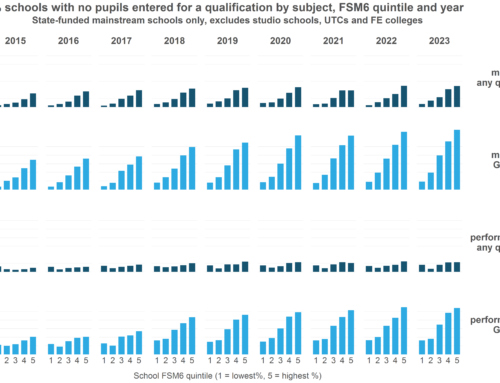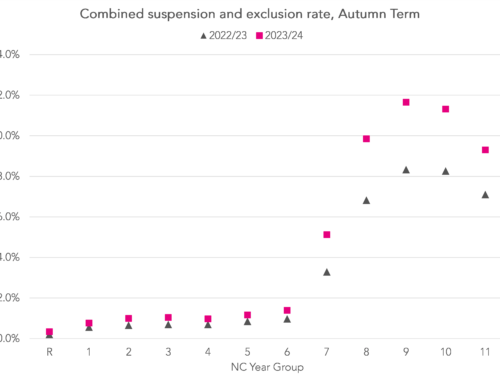We have previously examined the extent to which pupils leave the roll of state-funded mainstream secondary schools. In this post, we look at one of the destinations of pupils who leave the roll of a state-funded mainstream school: the independent sector.
(Today Ofsted has spoken out about unregistered alternative provision. To be clear, all of the education institutions looked at in this post are legal, registered institutions.)
In particular, we look at pupils who transfer to the independent sector after January of Year 10.
These are rare cases. Of the cohort in Year 10 in 2015, just over 1,000 pupils from a national cohort of around 550,000 had moved to the independent sector by summer 2016.
But as the chart below shows, this number has increased markedly in the last two years, and there appear to be pockets of the country where this practice is more prevalent than others.
Number of transfers to the independent sector from state-funded mainstream schools after January of Year 10

We only know that a pupil joins an independent school if they ultimately appear in performance tables data at the end of Key Stage 4. But this may only happen if he or she has been entered for a qualification, and it’s unclear for what proportion of these children this is the case. Pupils not entered for qualifications at independent schools may not be recorded in the National Pupil Database, and so we may underestimate the extent to which pupils transfer to the independent sector. This may well have affected some years more than others in the chart above.
As well as rising numbers of transfers, the percentage of pupils who transfer who were eligible for free school meals in Year 10 has also been increasing over the last ten years. Typically 15 per cent of the national cohort is known to be eligible for and claiming free school meals in any year. This figure has been more than 30 per cent among those transferring to the independent sector since 2013.
Percentage of pupils transferring to the independent sector who were eligible for free school meals

So what sorts of schools are pupils transferring to?
The table below shows a set of schools which, between them, have received a quarter of the Year 10-or-later transfers over the last two years. All provide alternative provision, mostly for pupils with behavioural, emotional and social difficulties. The admissions policy for LPW Independent School, for example, is here.
So of these late moves to the independent sector, they tend to be into alternative provision.
Independent schools receiving the most Year 10-or-later transfers, 2013/14 and 2014/15 Year 10 cohorts
| School | Local authority | Transfers |
| Flexible Learning Centre | Birmingham | 97 |
| LPW Independent School | City of Bristol | 66 |
| Include Bristol | City of Bristol | 54 |
| Education Links | Newham | 35 |
| Archway Academy | Birmingham | 35 |
| Sporting Stars Academy | Stoke-on-Trent | 30 |
| The Complete Works Independent School | Tower Hamlets | 26 |
| Harmonize Academy AP Free School | Liverpool | 25 |
| Spring Hill High School | Birmingham | 24 |
| Assess Education | Liverpool | 22 |
| South Park Enterprise College (11-19) | North Lincolnshire | 20 |
| Future First Independent School | Birmingham | 20 |
| Phoenix U16 | Stoke-on-Trent | 19 |
On average, 17 pupils per 10,000 nationally who were in Year 10 in 2013/14 and 2014/15 combined left and moved into the independent sector. However, the rate in the City of Bristol was over ten times higher. Rates were also high in Stoke-on-Trent, Birmingham and parts of London. (To some extent, this may be a function of how much state alternative provision exists.)
Number and rate of transfers from Year 10 in a state-funded mainstream school to the independent sector by local authority, 2013/14 and 2014/15 Year 10 cohorts
| Transfers | Y10 pupils | Rate of transfers per 10,000 pupils | |
| City of Bristol | 115 | 6,422 | 179.1 |
| Stoke-on-Trent | 73 | 4,840 | 150.8 |
| Kensington & Chelsea | 13 | 1,562 | 83.2 |
| Hackney | 35 | 4,247 | 82.4 |
| Greenwich | 36 | 4,559 | 79.0 |
| Islington | 24 | 3,049 | 78.7 |
| Birmingham | 186 | 25,551 | 72.8 |
| Middlesbrough | 19 | 2,932 | 64.8 |
| Newham | 44 | 7,418 | 59.3 |
| Solihull | 31 | 6,225 | 49.8 |
These transfers may well be taking place in the best interests of pupils. But in our view they should remain on the roll of the state-funded mainstream school from which they were referred, or at least be counted as such in the performance tables – unlike what is the case here.
We would also recommend making independent settings offering alternative provision a type of establishment in EduBase to distinguish them from other independent schools.
Want to stay up-to-date with the latest research from Education Datalab? Follow Education Datalab on Twitter to get all of Datalab’s research as it comes out.






Leave A Comment